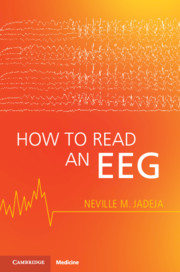Book contents
- How to Read an EEG
- How to Read an EEG
- Copyright page
- Dedication
- Contents
- Figure Contributions
- Foreword
- Preface
- How to Read This Book
- Part I Basics
- Chapter 1 Introduction
- Chapter 2 Polarity
- Chapter 3 Montages
- Chapter 4 Localization
- Chapter 5 Active Reference
- Chapter 6 Frequencies and Rhythms
- Chapter 7 Maturation
- Chapter 8 Normal Adult EEG
- Part II Interpretation
- Part III Specific Conditions
- Appendix How to Write a Report
- Index
- References
Chapter 6 - Frequencies and Rhythms
from Part I - Basics
Published online by Cambridge University Press: 24 June 2021
- How to Read an EEG
- How to Read an EEG
- Copyright page
- Dedication
- Contents
- Figure Contributions
- Foreword
- Preface
- How to Read This Book
- Part I Basics
- Chapter 1 Introduction
- Chapter 2 Polarity
- Chapter 3 Montages
- Chapter 4 Localization
- Chapter 5 Active Reference
- Chapter 6 Frequencies and Rhythms
- Chapter 7 Maturation
- Chapter 8 Normal Adult EEG
- Part II Interpretation
- Part III Specific Conditions
- Appendix How to Write a Report
- Index
- References
Summary
Frequency is the number of times a waveform occurs per second (one big square). Rhythms in addition to frequency have characteristic features of location, morphology, reactivity, and state dependence. Frequencies are descriptive; rhythms are diagnostic. Clinically relevant frequency bands include delta (0.5-4 Hz), theta (5-7 Hz), alpha (8-13 Hz), and beta (14-30 Hz).The alpha rhythm is an obligate feature of normal wakefulness, and it has considerable variations. Abnormal alpha rhythm may be slow, asymmetric, or unreactive (Bancaud’s phenomena). Excessive beta is associated with sedative medications. In most normal adults, theta and delta rhythms are limited to drowsiness or sleep; their occurrence during wakefulness may be abnormal.
Information
- Type
- Chapter
- Information
- How to Read an EEG , pp. 32 - 39Publisher: Cambridge University PressPrint publication year: 2021
References
Accessibility standard: Unknown
Why this information is here
This section outlines the accessibility features of this content - including support for screen readers, full keyboard navigation and high-contrast display options. This may not be relevant for you.Accessibility Information
- 1
- Cited by
